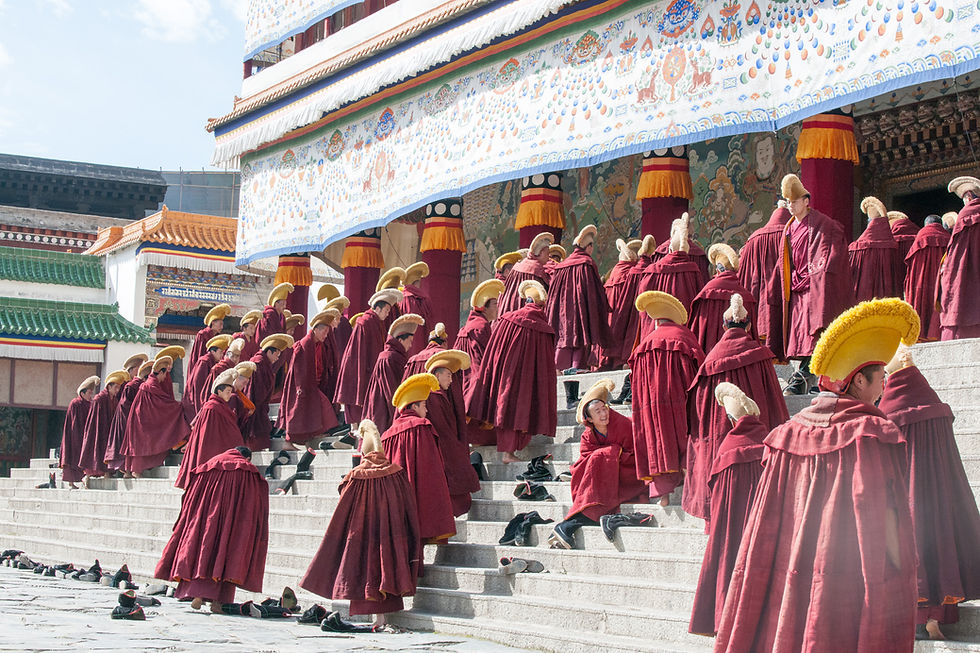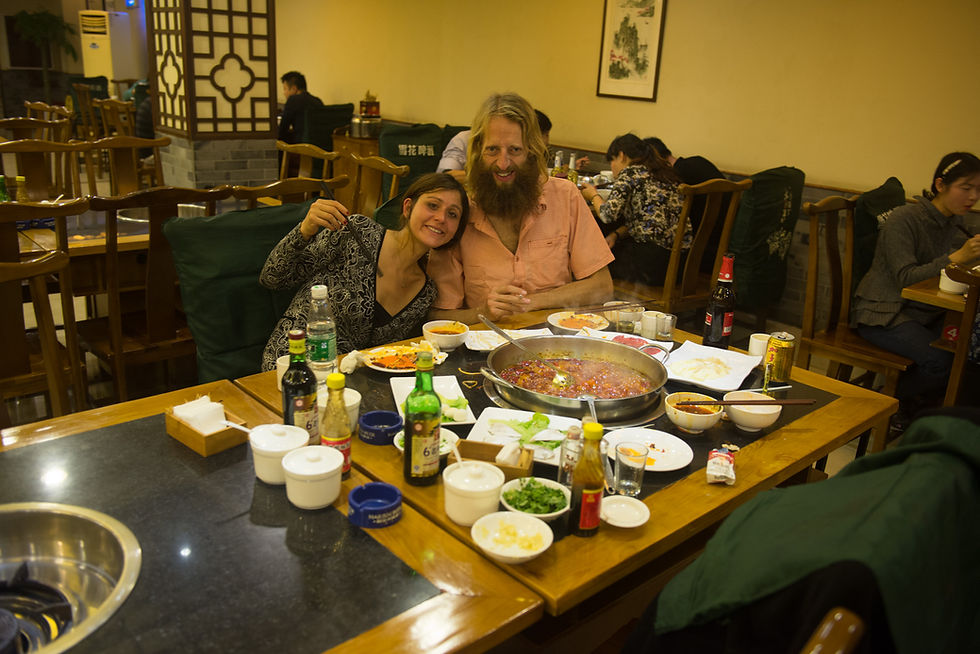CHINA - THE NEW LAND OF UNLIMITED OPPORTUNITIES, PART II
- Ulf
- Dec 10, 2015
- 7 min read
Tibet and especially Lhasa had something mystical for us and all sorts of images fuelled by movies like “Kundun” or “Seven Years in Tibet” and the western press pre-occupied our imagination. Arriving in Lhasa didn't mean arriving in the backwardly capital of a theocracy full of monks in orange or red dresses, it meant arriving in a buzzing city connected to the outside world with the latest infrastructure (high-speed roads, new airport, railroads) full of new urban development areas, big screens and of course a lot of impressive historical sights in an extremely well maintained and almost hyper clean environment.

The next thing that hit our eyes is the number of Chinese tourists. Tibet and Lhasa are amongst the most popular tourist destinations in China and October with its clear skies, colourful forests and fresh snow in the high mountains is one of the best times to visit it. We strolled through the city, visited the Drepung monastery, the Jokhang temple and of course the Potala palace - formerly the spiritual and secular power centre of Tibet and home of the Dalai Lama. As we had to wait for our permissions to enter the Everest area we enjoyed a few more days in the city, mostly at the markets and the hundreds of small shops.

We bought Thangka paintings, down jackets and lots of other stuff and enjoyed an open air spectacle named Princess Wencheng - an epic story about the wedding between the Chinese princess Wencheng and the Tibetan king Songtsen Gampo (who also brought Buddhism to Tibet) in 641 AD. Soon we headed west along the Tsangpo river and up towards lake Yamdrok (elevation of 4’440m) - one of the holy lakes in Tibet - with artificially looking colours and breathtaking sights. On our way to Shigatse we passed again above 5’000m and observed the busy farmers collecting the harvest in the valleys. The road took us further west to New Tingri through awesome scenery and across high passes. For the first time we had trouble starting our Rouletout but after a while we headed off towards Rongbuk, the last small village and monastery before the Everest basecamp. We passed the military check point and a new road took us above 5’200m and down to Rongbuk in front of the Everest. The nights at 5’000m were cold but the days were perfect with clear skies and impressive sights of the top of the world.

Contrary to our expectations (and common rule) and just due to the fact that most tourists had already left the military allowed us to climb one of the mountains next to the monastery, a nameless peak with 6’021m. We left early morning in the dark to see sunrise on Everest from 5300m where Berna decided to turn around. Mutlu and myself climbed the rest of the pebbly, gravelly mountain and were rewarded with perfect views on Everest, Cho Oyu, Lhotse and Xixabangma. After another day in Rongbuk where we hiked to the basecamp of Everest it was time to leave again. Rouletout decided otherwise as we still had a mix of 0°C and -20°C fuel in our tanks the fuel filters were clogged. We prepared a fire and heated the tank and after a while we were ready to move just as a snowstorm started. The way took us back again towards Shigatse and along the Tsangpo back to Lhasa where our new toy, a camera drone from DJI was already waiting. After two more nights in Lhasa we started heading north on G109 along the impressive China-Tibet-Railway until Damshung. For our stay in Namtso National Park at 4’700m we put more -20°C fuel into our tanks. Due to severe snow storms we had to wait for a few hours to cross the pass to Namtso. The reward was incredible; Lake Namtso (the 2nd holiest lake in Tibet) and its surroundings are stunning and with all the pilgrims touring a small peninsular truly had something mystical.

We spent two days in the area, hiked and just enjoyed the views and people before we headed north again through brown highlands full of Yaks towered by snowy peaks towards the military town of Nagqu. Traffic on this long and remote route consists mostly of big trucks bringing supplies into Tibet. We climbed again above 5’000m, stopped for the night in Tutohohe near the first bridge across the Yangtse and then crossed the famous Koko-shili (the Tibetan nomans-land full of wild deer, donkeys and other sorts of wild animals) before we left Tibet and started our decent to Gormud (2’800m). Gormud (the cities territory is as big as Greece!) is a dusty town surrounded by salt lakes and an important railway crossing point. We were also impressed by the number and size of solar power plants and wind farms around the city that fuel the growth of this outpost of civilisation in Qinghai province. For us Gormud meant a change in direction, from now on we headed east again through desert like scenery towards the biggest lake in China, lake Qinghai. The food also changed again and a significant muslim influence could be felt in many of the small food stalls with their perfect noodles.

For most of the trajectory new high-speed roads made driving really easy and relaxing and on our way through Xianin and further to Xiahe we again got a glimpse of the infrastructure investments going on in China. Regardless of how mountainous a region, how wide a river or how steep a mountainside high-speed roads and high-speed railway links are being built at an incredible speed, defying any geographical barrier. Amongst other things this is one reason why China used more cement between 2011 and 2013 than the U.S. used in the entire 20th Century! (1) The last stretch to Xiahe in Gansu province led us through the canyons of the upper courses of the Yellow River, along impressive sandstone mountains and through autumnal farm land with the occasional small monastery. For us Xiahe with its huge Labrang monastery (it once housed 4’000 monks, now about 1’500) was the last encounter with Tibetan Buddhism at this scale and for that last encounter we chose a lucky day. On this special day (we still don’t know what it actually was) we were part of a small group of people who could observe how many of the monks of Labrang monastery met in front of the big assembly hall to pray before they were allowed to enter for further ceremonies and prayers.

Stunned by the scenery and the sounds we spent a few hours in front of and in the big assembly hall before we continued our way towards Chengdu. Again we were impressed by the landscapes, stopped in Maoxi (the main town of the Chang minority) with its Aztec-like pyramids and temples and followed the Minijang river into Chengdu, the capital of Sichuan and the “hometown of Pandas” in China. With its 14 million inhabitants it was voted one of the most liveable cities of China; for us however it was the first visit to a big Chinese city and we didn’t really know what to expect. The list of action items for Chengdu was pretty long. First and foremost we had to fix a small technical problem that we had since Tibet: every time our tachometer stopped working after about 20 minutes of driving which resulted in different types of subsequent errors on our dashboard. As most businesses in China also the Mercedes Trucks workshop welcomed us on Sunday and it took only a few minutes to identify the impulse generator as the source of the problem.

As this specific spare part was not on stock we were invited to stay on the premises of the workshop, using the WiFi and other infrastructure for the next few days and explore the city from this convenient location at the outskirts of town. Whenever we were at the workshop over lunch we were invited to eat with the team, when we tried to do our laundry someone took it out of our hands and got it done, Mutlu was playing with dog friends and got spoiled by the workers and whenever we wanted to go down-town a “Uber-car” was organised by one of the extremely friendly team members. In short, next to fixing our problems the Mercedes crew did everything to make our stay - which in the end added up to a full week - as convenient as possible.

With the help of Losang we finally found a shop that was able to order new tires of our dimension and we also fixed and bought several other small things that we had on our list for a while (most of that on taobao.com, the Chinese eBay and by now the biggest on-line shopping platform in the world). In between we visited the famous Panda research base with Panda’s of all sizes (probably the most spoiled species that exists), toured the really enjoyable city with its modern centre (still displaying a very big Mao statue that everyone just passes by) and the beautifully maintained old parts of town like Jingli street that are really buzzing at night, offering Shizuan operas, tons of souvenir shops and local food. One evening we were invited by Chengdu Culture & Tourism and the newspaper Chengdu Daily for an interview about our travels and for a famous, delicious and very spicy Shizuan hot pot.

Time passed quickly and we moved on to our final stretch in China. We left Chengdu and Shizuan behind and moved into Guizhou province, on paper one of the poorest provinces of China and on to Getu, a small village at the end of a beautiful valley, famous for its river that caved amazing structures into the rock, endless caves and latest since 2011 (when Petzl organised the rock trip there) for its rock climbing. It didn’t take long and we fell in love with this tiny Chinese village and its friendly population. But as always, more on that in our next blog entry. (1): Washington Post, 24-Mar-2015 (How China used more cement in 3 years than the U.S. did in the entire 20th Century)




Comments